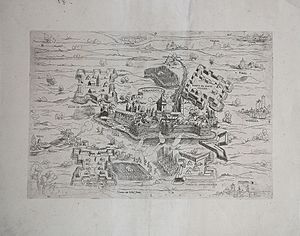Siege of Mirandola (1551) facts for kids
Quick facts for kids Siege of Mirandola |
|||||||
|---|---|---|---|---|---|---|---|
| Part of the Italian War of 1551–1559 | |||||||
 |
|||||||
|
|||||||
| Belligerents | |||||||
| Mirandola |
|||||||
| Commanders and leaders | |||||||
| Ludovico Pico, Piero Strozzi |
Camillo Orsini, Alessandro Vitelleschi, Giovanni Battista del Monte |
||||||
| Strength | |||||||
| 400 | 4000 | ||||||
| Casualties and losses | |||||||
| c. 200 | c. 1800 | ||||||
The Siege of Mirandola was a big fight that happened in Italy between July 1551 and March 1552. It was part of a larger conflict called the Italian War of 1551–1559. This war involved many powerful groups in Europe.
The city of Mirandola was a small, strong city-state. A city-state is like a tiny country that is just one city and the land around it. Mirandola had joined forces with France. Because of this, Pope Julius III, who was the leader of the Papal States, decided to attack Mirandola.
Contents
What Was the Siege of Mirandola?
A siege happens when an army surrounds a city. They try to stop anyone from going in or out. The goal is to make the people inside run out of food and supplies. This forces them to give up. The Siege of Mirandola was one such event.
Why Did the Siege Happen?
Mirandola had chosen to be friends with France. This made Pope Julius III very unhappy. The Pope wanted Mirandola to be on his side. He saw their alliance with France as a threat. So, he sent his army to take control of the city.
Who Was Involved?
On one side was Mirandola, supported by France. Their main leaders were Ludovico Pico and Piero Strozzi. They had about 400 fighters.
On the other side was the Pope's army. This army included soldiers from the Papal States, the Holy Roman Empire, and Spain. Their leaders were Camillo Orsini, Alessandro Vitelleschi, and the Pope's nephew, Giovanni Battista del Monte. They had a much larger army, about 4,000 soldiers.
What Happened During the Siege?
The Pope's army surrounded Mirandola. They built four forts around the city to block it off. However, the siege lasted for many months. This was partly because the Pope's commanders did not always agree.
Unlike an earlier siege in 1511, the ditches around Mirandola did not freeze. This made it harder for the attackers. Also, the knights inside Mirandola often rode out. These surprise attacks, called "sallies," made it hard for the Pope's army to communicate between their forts.
In the spring of 1552, the siege was still going on. The Pope was waiting for more soldiers, called Landsknechts, to arrive from Germany. These were professional soldiers from the Holy Roman Empire.
The End of the Siege
In March 1552, something unexpected happened. A group of Mirandola's fighters went on a raid. They surprised the Pope's nephew, Giovanni Battista del Monte, while he was hunting. He was killed during this raid.
This was a big blow to the Pope. He wrote to the Emperor Charles V that he would stop the siege. Soon after, the Pope's army left Mirandola. This meant Mirandola and France had won this battle.
Sources

